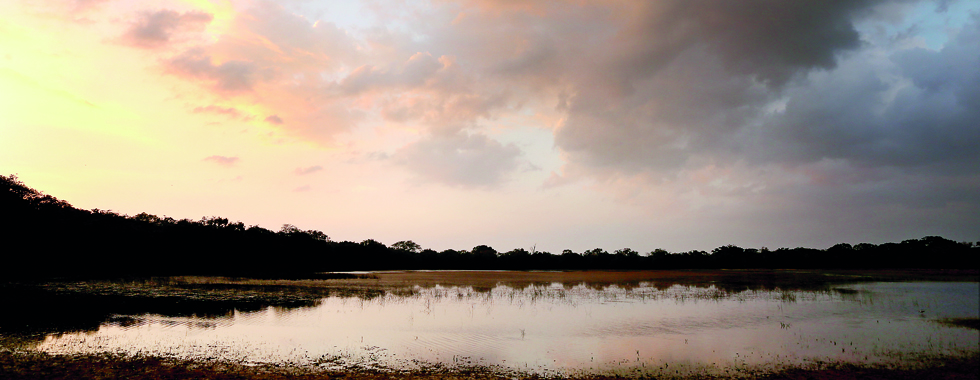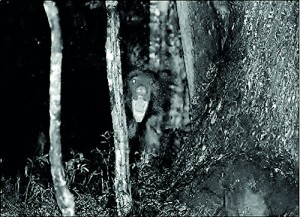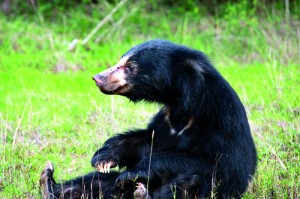Armed with camera traps the hunt is on
Wilpattu beckoned tantalizingly.

Wilpattu’s grandeur. Pix by M.A. Pushpa Kumara
For a brief moment in time, deadlines and headlines and also domestic responsibilities placed on hold, we answered the call of the wild, spending a day and a night amidst the pristine beauty of the largest National Park in the country.
And unfold Wilpattu did its grandeur with stunning visions of both its fauna and flora and also its unique villus.
Disappointed, however, we were that we could not catch even a fleeting glimpse of one of the most iconic large land mammals of the country – the sloth bear, among Sri Lanka’s ‘Big Three’ (the others being the elephant and the leopard).

Sloth bear captured at night on a camera trap
The sightings of the sloth bear, which environmentalists and villagers say has a reputation as “one of the most dangerous animals in the wilds”, have been few and far between.
This is why deep within Wilpattu, where anecdotal evidence suggests the presence of this elusive creature, a quest is on.
Away from their families and the comforts of their homes, eating meagre meals and sometimes living on water and camping amidst the stillness of Wilpattu broken only by the orchestras of insects, researchers Ranil Nanayakkara and Nilantha

‘Shot’ by Ranil and Nilantha on their cameras
Vishvanath of ‘Biodiversity Education And Research’ which aptly reads as BEAR are on a ‘hunt’ in earnest. They are not newcomers to the field of research, with Ranil well-known for his work on the dugongs and he and Nilantha carrying out joint work on tarantulas.
This is a hunt of a different kind and they are on the trail of the sloth bear, armed with unobtrusive ‘camera traps’ which they fix to trees in areas where they believe are their haunts. They are bent on capturing images of these creatures while also spending long hours squinting at and following their pug-prints and scats (droppings).

Nilantha (left) and Ranil fixing a camera trap to shed light on the lives of the sloth bear
A proper census is needed before a conservation model can be established for the sloth bear, says Ranil, explaining that they are attempting to estimate the sloth bear population density in the Wilpattu National Park.
Pointing out that not much research has been carried out on the sloth bear, as the major focus has been on the elephant and the leopard, he underscores the importance of this project in the light of fears that their population has dwindled.
Except for a study in the 1970s and a collaring project to find the sloth bear’s home range at Wasgamuwa and Yala in the early 2000s, this is an unstudied species, says Ranil.
Chatting with the Sunday Times at the Manawila bungalow within Wilpattu during a break in their pursuit of the sloth bear, he compares this project to others such as Project Tiger in India.
Attempting to conduct a census is challenging, says Ranil, as there is not much research on the identification of individual sloth bears. This is why camera trapping is being used as a census technique while also capturing them on the powerful cameras that the duo carries with them on their forays into the Wilpattu wilderness.
They have mobilised both the trackers and safari-jeep drivers to keep tabs of the sloth bears that they sight, as the “park is very big” and Ranil and Nilantha cannot traverse every inch of it. “Then we can put together all the information we gather and establish individual identities,” Ranil adds.
The camera trap technique is explained by Nilantha. Based on a Google Earth aerial map, a virtual plot of 10sqkm has been demarcated, with that too being sub-divided into 1kmX1km grids. This is the area in Maradanmaduwa where the camera traps have been placed.
Whenever any animal passes by a motion sensor detects it and transmits 10-second video footage, says Nilantha going into the technicalities. The images of the sloth bears are then used for the identification of individuals by marks such as claw injuries suffered in fights. The images of the sloth bears would also be compared with the photographs that both Ranil and Nilantha click on their sophisticated cameras.
Another technique is the 10km line-transect which uses the silent-device census in which Ranil and Nilantha drive up and down along that area, recording all sightings.
The team is also closely studying pug-marks and meticulously measuring their size to confirm whatever data that the camera traps would yield, while also looking at scat density. The pug-mark, particularly of the hind-foot would give a rough idea of the size and weight of the sloth bear, points out Ranil, adding that they are also monitoring the foliage to get an inkling of their preferred habitat.
Six months into the project, Ranil is of the view that they need to collect information for at least three years to get an accurate picture on the density, as the ranging patterns of the sloth bear change from season to season.
Dang or palu thiyena kaleta, the density would be more in that area, smiles Nilantha.
An analysis of the scats would reveal the dietary habits of the sloth bear, says Nilantha, what they have been eating at a particular time, be it insects or termites or fruits such as weera, palu and dang. Adds Ranil: “The scats have a seasonal variation.”
Unlike many others, this research project would not be just a one-off effort. Once this reaches culmination, these plots would remain, leaving a strong pulse through which an increase or decrease in the sloth bear population in that particular area could be monitored.
The project, hopefully would not end in one year, but expand to cover the lifestyle of the sloth bear, their behavioural patterns and also which is deadlier – the male or the female.
With the sloth bear only found in India and a sub-species endemic in Sri Lanka, this would truly be a study of global importance to stymie this species from vanishing from the face of the earth.
| A marriage to protect our biodiversity
It is a unique partnership. The ‘Estimate of the population density of sloth bears at the Wilpattu National Park’ has seen the light of day after BEAR joined hands with CIC Holdings with the broker of this marriage being the Sri Lanka Business and Biodiversity Platform.  Mr. Ranatunga Business has a responsibility towards society but in recent times we see a polarization between the two. We felt the need for the Platform to bridge this gap, said CIC Managing Director and CEO Samantha Ranatunga, himself a wildlife enthusiast. He plays a dual role – being an active member of the Platform as well as funding the sloth bear project including the importation of the camera traps and other logistics. The Platform had been cobbled together as a joint initiative of the Ceylon Chamber of Commerce, the International Union for the Conservation of Nature (IUCN) and Dilmah Conservation in November 2012. Mr. Ranatunga is Chairman of the Platform’s Advisory Committee. Pointing out that there are many initiatives by the private sector linked to biodiversity such as gathering and dissemination of information and also preservation and conservation, Mr. Ranatunga said that the Platform is a meeting point. Without working in isolation, the Platform would provide an arena for the sharing of best practices, exchanging stories of excellence and also bringing into the spotlight the work of unsung heroes while facilitating important research such as the sloth bear project. The sloth bear project had been picked as there are fears over their dwindling numbers, the Sunday Times understands. With the ferocity of the sloth bear being in no doubt and its regular haunts being in the northeast, there have been suspicions that frequent human-bear encounters  Ms. de Silva would have been disadvantageous for the latter. There has been a major lack of research on the sloth bear and the Platform had felt the need for a baseline study to build-up a database, it is learnt. “This is a commendable initiative,” said Prof. Devaka Weerakoon of the University of Colombo who provides scientific guidance on methodology on a voluntary basis, adding that the sloth bear is the most threatened species in recent times. The sloth bear is listed as ‘Endangered’ in the National Red List 2012 for Sri Lanka. Reiterating that the sloth bear has not been looked at in a scientific manner, Prof. Weerakoon recalled just one other project in recent times — collaring the sloth bear or using telemetry at Wasgomuwa and Yala. This is the “next serious study” which is non-intrusive and would have no impact on the animals. He too concedes that there is a deep mistrust of the private sector that it is there only to make profits but not put something back and lauds the efforts of the Platform to dispel this misconception. “We’ve just passed the halfway mark of the sloth bear study,” says Platform Coordinator Harshini de Silva, adding that this is Phase 1 and there are plans to extend the study. Ten camera traps have been imported for the study which is being conducted in collaboration with the Wildlife Conservation Department’s Research and Training Division. The financial management of the project is by the Platform.  Prof. Weerakoon Referring to how individual bears would be identified, Prof. Weerakoon says that unlike the leopard with its specific spotting it may be more difficult in this case as they have no significant markings. “Torn ears or broken tails would be taken into account,” he adds. While the data generated by this study would be analysed to determine the sloth bear’s habitat needs, Ms. de Silva is quick to point out that the camera traps have yielded “an unexpected bonus” – images of other nocturnal animals. With a vital need being more such studies and not only on animals dubbed “charismatic” what everyone has on their minds is succinctly made vocal by Mr. Ranatunga about the need to safeguard Sri Lanka’s biodiversity. “If we lose it now, it will be lost forever,” he says with finality. |



